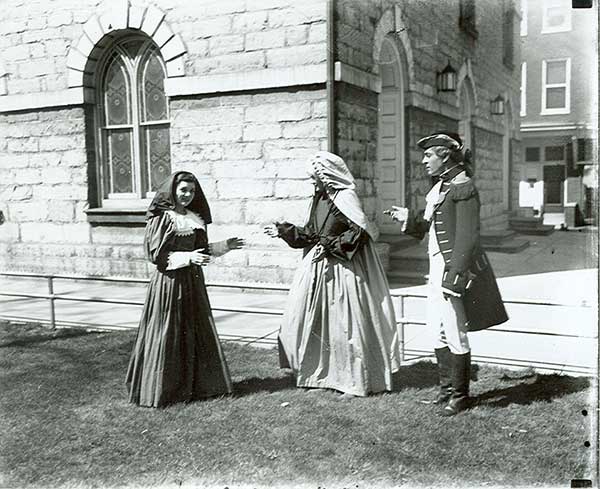The National Register of Historic Places in Cumberland County
The National Register of Historic Places was organized by the National Historic Preservation Act of 1966.

A pageant in front of the First Presbyterian Church, in 1934, showing people dressed in colonial costumes, in celebration of the church's 200th anniversary. This was a reenactment of the story of the return of Regina Hartman, who had been held captive by the Indians and was returned in 1764. (H-126 Cumberland County Historical Society, Carlisle, PA)
During the colonial era, Cumberland County was on the western frontier of colonial settlement. Although treaties had been signed allowing legal settlement, peaceful relations with Native Americans was not achieved until the 1770s. During the French and Indian War in the 1750s and the subsequent conflict known as Pontiac’s War in the 1760s, Cumberland County and points west were the scene of frequent armed conflicts. One outcome of those conflicts was the taking of white prisoners by the Indians.
In 1764, following cessation of Indian wars in colonial Pennsylvania and Ohio, a treaty was agreed to between Native Americans and the colonial military forces headed by Henry Bouquet. As part of that agreement, white captives who had been taken by the Indians over a number of years were to be returned to their families. For many of these captives, their time with the Indians had been extensive and they were fully acculturated to their new way of life. In some cases, reunited captives returned to their Indian homes after a short time back with their white families. One of those reunions occurred at Carlisle and the story of that reunion has been circulated for more than 250 years.
In late November of 1764, a group of captives from the west was sent to Carlisle to meet with people who had lost family members over the years. One German woman from eastern Pennsylvania was searching for a daughter lost nine years previously. At the time of capture, the child was only two years old. Mrs. Hartman could not identify the child, now 11 years old from the group of captives assembled at the square in Carlisle. She described to Colonel Bouquet how she had sung German hymns and songs to the child. He suggested she sing one of those hymns to see if it sparked any memories in any of the young captives. Mrs. Hartman then began singing. The opening words of the hymn in English are
“Alone and yet not all alone, Am I, in solitude though drear,
For when no one seems me to own,
My Jesus will himself be near.”
Memory stirred in one of the captives and she rushed into the arms of her mother and subsequently returned with her to Berks County. This is the well-known story of Regina Hartman, the white captive girl who was returned to her family.[1]
The National Register of Historic Places was organized by the National Historic Preservation Act of 1966.
1 Cyrus Cort, Col. Henry Bouquet and His Campaigns of 1763 and 1764, (Lancaster, PA, Steinman & Hensel, Printers), 1883, 69-72.